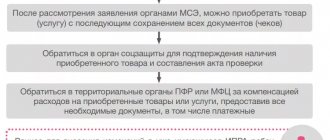Why is paternal capital needed?
By 2021, Russia's population began to decline. And this despite the fact that the state is investing a lot of money and offering a whole range of mechanisms that should increase the birth rate in the country.
In 2021, Sergei Rybalchenko, deputy chairman of the Commission for Support of Family, Motherhood and Childhood, prepared a 70-page report in which he analyzed the demographic situation in the country. The conclusions turned out to be disappointing - the number of Russians is decreasing: the number of children born has dropped to the levels of 2007, when maternity capital was first introduced.
The total fertility rate was 1.59 children per woman, while for natural population growth in Russia this rate should be 1.95-2.05 children per woman. According to Rybalchenko, it is urgent to take measures to reverse this trend.
Rybalchenko sees financial support for large families as such a measure. It is large families, the author of the report believes, that will be able to ensure the growth of the Russian population. Therefore, he proposes, along with maternity capital, which is provided to families with 1 or 2 children, to introduce paternal capital. This payment should be provided to families in which 3 and subsequent children were born. Why paternal? As the author of the report explains, according to statistics, the father of the family is the initiator of the birth of the third and subsequent children.
Paternal capital: myth or reality
So, does paternal capital exist in Russia or not? The answer is clear: it doesn’t exist.
. A couple of years ago it was proposed to introduce it, but in the end the proposal “was not completed.”
Although, if we consider paternal capital not as a separate category of payment, but from the factual side (that is, that it is the father who will receive state support at the birth or adoption of a child), then such a possibility is provided in Russia. But only if maternity capital was not used and the mother’s right to use it was terminated.
Not a replacement, but an addition
As News.ru’s interlocutor clarifies, since 2014, the number of births per thousand people has been consistently decreasing in Russia - from 13.3 to 10.9 people in 2015–2018. The fertility rate (the average number of children born per woman) decreased from 1.77 to 1.61 over the same period. The corresponding national project “Demography” plans to raise the indicator to 1.92–2.05 by 2024. It is obvious that the new measure will at least help stabilize the birth rate.
Moreover, it is important that this is precisely “father’s” capital. It is more effective than increasing maternity capital by the same amount. Here the approach is from the other side: it is necessary not to replace maternity capital, but to supplement it. According to the principle “not instead, but together ,” says Goikhman.
In his opinion, for the country such support is not a waste of money, but an investment that will be returned with interest in the future. They will return due to increased consumer demand for goods and services from such families, by stimulating the birth rate and the birth of new citizens. Those who will subsequently replace the older generation in work and public life.
We are talking only about large families
As the OP of the Russian Federation explains, now 90% of the total funding within the framework of the national project “Demography” is aimed at families with one or two children, and the new measure will affect families with many children. In demographically successful countries, more than 40% of the funds allocated within such projects go to support the birth of the third and subsequent children, Izvestia writes.
According to investment strategist at BKS Premier Alexander Bakhtin, in conditions when real incomes of the population are not growing, and a significant part of citizens only have enough money for food and clothing, the initiative of the Public Chamber is of particular relevance. Especially when the state is faced with the task of increasing the birth rate and dramatically improving demographic indicators. However, this measure will not radically change the financial situation of Russian families, and its effect will not be immediate.
The main pitfall here is the possible difficulty of obtaining such help. It is important that the initiative does not stall due to bureaucratic obstacles.
Alexander Bakhtin
investment strategist at BCS Premier
When the law comes into force
President of Russia V.V. Putin got acquainted with the project and has already supported it. It is possible that in 2021 several regions of the country will become pilot areas where the program will be tested in practice. Most likely we are talking about the Far East . https://upfrf.ru/blog/otcovskij-kapital.html. Later it will be joined by the Northwestern Federal District and the Central Federal District (Central Federal District), where the demographic situation leaves much to be desired. If the effect is positive, then by 2023-2025. the law on Father's Capital will be extended throughout Russia. After all, financial support for large families is a priority area for which the authorities are willing to spend money from the budget.
Who is entitled to it and how much: the Public Chamber explained the idea of introducing paternal capital
The Public Chamber of Russia proposed introducing paternal capital. How it will differ from the maternal one and what its size is, “Evening Moscow” learned from the author of the initiative, chairman of the OP commission on demography, protection of the family, children and traditional family values, Sergei Rybalchenko.
What is the difference from maternity capital
First of all, Rybalchenko emphasized in a conversation with VM, in the chamber this form of support is called multi-child capital. According to the publication’s interlocutor, paternal capital will be provided at the birth of the third and subsequent children. Like maternity capital, the new payment is a one-time payment, the social activist specified.
— Paternal capital is more family-oriented than maternal capital, since the latter can be provided to a mother without a father, while paternal capital is provided for a third child when three children were born in the same family . Father's capital carries not only material, but also family value. “It will encourage fathers to continue family traditions,” says Rybalchenko.
He drew attention to the fact that the Public Chamber proposed introducing this support measure in 2021. Even then, surveys of families were conducted and during the survey it turned out that many respondents would like to expand the scope of application of their father’s capital, said the author of the initiative.
- After all, this is not money “in hand”, but funds that can be used for implementation in various directions. For father's capital, we want to expand these areas . The families we interviewed suggested, for example, allowing these funds to be used to purchase a family car, renovating a house, developing their own farm and other purposes,” he clarified.
The main goal of the new initiative, according to the expert, is to celebrate the role of the father and draw attention to families with strong traditional ties.
— It’s called paternal because, according to statistics, 40 percent of mothers with many children do not work, but raise children. In such cases, providing for the family falls on the shoulders of the father, Rybalchenko added.
Photo: pexels.com / Andreas Wohlfahrt
What will be the amount of paternal capital?
According to the social activist, the amount of paternal capital will be comparable to maternal capital . At the same time, the expert recalls, in 2021, at the birth of the first child, the family receives 483.8 thousand rubles. For the second child - another 155.5 thousand. In total, Rybalchenko says, the amount of maternity capital funds as a federal support measure reaches 639.4 thousand rubles for the second child. A similar amount is due for the third and subsequent child born or adopted from 2021, if previously the family did not have the right to maternity capital.
Among other things, adds VM’s interlocutor, at the birth of a third child, the state provides 450 thousand rubles to repay the mortgage loan.
Some experts in the OP, according to Rybalchenko, believe that paternal capital should be twice as much as maternal capital, but so far this proposal has not been approved. According to surveys conducted by the chamber, about half of families would like the father's capital to be equal to the amount of maternity capital for the second child (639.4 thousand rubles). In turn, approximately 30 percent of families said that capital for many children should be twice as much as maternal capital, the social activist noted.
Is it possible to receive both paternal and maternal capital?
In theory, this is possible, said the chairman of the OP commission on demography, protection of family, children and traditional family values. According to him, this is feasible in the context of the following analogy: large families can receive maternity capital as a federal payment and maternity capital as a regional support measure.
— In theory, you can have two payments from the state, but from different entities. For example, in the Sakhalin region, after the birth of a second child, families are simultaneously provided with federal and regional maternity capital. That is, there are two capitals for one family - federal and regional. And here there will be one father’s and one mother’s,” the social activist explained.
Photo: Andrey Nikerichev / AGN Moscow
Where does the state get the money for the new support measure?
Answering this question, Rybalchenko pointed to the authorities’ intention to support demographics, which will not happen without providing assistance to large families.
— Our birth rate has decreased recently. Taking this into account, certain reserves have appeared that we can rely on (from the point of view of financing the project - note “VM”). At the same time, fewer third children are born in families than the first two, so the father’s capital in terms of implementation will not be a very expensive step, the social activist believes.
He also drew attention to the fact that 90 percent of maternal capital is usually spent on improving the living conditions of a particular family. According to Rybalchenko, every ruble spent on construction is returned in the form of 30–40 kopecks, which go as part of taxes to budgets at all levels.
“Taking into account the attraction of additional funds, the measure we propose is a returnable investment, and not expenses that we will have to look for in the budget,” the expert concluded.
Why was there a need for paternal capital?
The Public Chamber reported that in 2021, after a slight increase in 2013-2015, the birth rate began to decline again, and natural population growth gave way to decline. These processes are seriously influenced by factors such as the demographic hole of the 1990s and the fall in real incomes of the population.
As a successful example that will help break the negative trend, the authors recalled the experience of the Sakhalin region. Here, thanks to large-scale programs to support large families, a significant increase in the birth rate was recorded. The number of families with a large number of children in the Sakhalin region has doubled over 5 years.
According to the calculations of the report’s authors, if the Sakhalin experience of supporting families is launched throughout the country, this will require significant injections of funds in the amount of up to 2% of GDP annually. But this is still much less than in European countries that today are pursuing policies to stimulate the birth rate.
Also analyzing the provisions of the national project on demography, the Public Chamber noted that most of the funds provided for by the project are aimed at payments for the first or second child in the family. Families with a third child receive only 10% of the total planned project funds.










